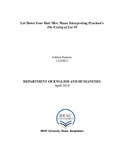Let down your hair Mrs. Maas: interpreting Pynchon’s The Crying of Lot 49
Abstract
My paper examines the idea that in the novel The Crying of Lot 49, the
obscure plot is mostly interpreted as the post modern adoption of a world
famous fairytale Rapunzel. In The Crying of Lot 49, there is an odd sense of
detachment which is not so much from reality, but it is certainly the case too,
as from itself. In my view this detachment from itself is mainly caused by an
ontological contingency, an absence of truth. But, it is also owing to a layered
thematic structure, where the different layers are presented not as sediments
but rather as a palimpsest rendering each layer perspicuously transparent but
lacking in cohesion. Reading Pynchon’s novel is a peculiar experience as the
story unfolds, the reader is made increasingly word-conscious as each word
becomes, figuratively, more conscious of both its etymological roots and its
semantic field, so that eventually each word potentially suggests a whole
knotty cluster of meanings .This tends to perplex the reader, mainly because
every thematic is overly emphasized; e.g. almost all the names are linked to
Freudian psychology, they have psycho sexual connotations and connotations
of paranoia. All thematics pertaining to religion are somehow related to death.
They are juxtapositions of Christian, Jewish, Buddhist and ancient Egyptian
theology and mythology picked randomly and served as a bowl of magic soup.
A well-known fairy tale frames the story, whereas the story itself is set up as a
detective story with its protagonist Oedipa Maas in the role of the classic
private-eye who struggles to discern reality from appearance in a world where
every clue is prepared and laid out by her former, dead lover. All she has to do
as executor of his will is follow the dead man’s instructions whatever they are
and wherever they take her.
The names, religious instants, fairy-tale and detective story of this novel are
foregrounded thematics that have all been transformed into free flowing states
disengaged from their usual marks of identification. They have become
simulacra. In my view, the constant conflict between the dichotomy of reality
and appearance and its eventual breakdown is a strong theme in this story. The
plot of Pynchon’s story is presented in the form of a detective story which is
epistemological. The protagonist sets out on a quest to unravel what seems to
be an extensive conspiracy revolving around an underground postal service
system. My thesis proposes that this epistemological quest conceals an
obscure plot, which permeates and supports the entire story. This obscure plot
is the well- known fairy-tale Rapunzel, but presented in a postmodern
variation, which, contrary to more modern representations, seeks to up-hold
the traditional formula for fairy-tales: an innocent story on top and underneath
deep, dark murky waters of meaning that may or may not be penetrated.
Keywords
English and humanitiesDescription
This thesis report submitted in partial fulfillment of the requirements for the degree of Bachelors of Arts in English at the Department of English and Humanities of BRAC University, 2014.Department
Department of English and Humanities, BRAC UniversityType
ThesisCollections
- Thesis, B.A. (English) [647]

